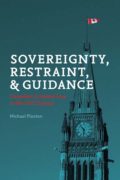Michael Plaxton
Showing 1–16 of 17 results
| Title & Subtitle | Abstract | Contributors | Pages | Year | Purchase |
|---|---|---|---|---|---|
|
From  “A Complex Piece of Writing” |
Chapter 7 examines the judicial treatment of section 163(8) of the Criminal Code, which defines “obscenity.” We will see that the history of the Supreme Court’s approach to this … | Michael Plaxton | 42 | 2019 | $4.20 Add |
|
From  A More Modest Principle of Voluntariness |
Chapter 8 argues that, in construing offence provisions, courts have proceeded on the basis that it would be absurd to attribute an intention, on the part of Parliament, to target involuntary … | Michael Plaxton | 25 | 2019 | $2.50 Add |
|
From  Coda |
Chapter 15 concludes the book, and provides an overview of the three theses explored in the text: the statutory interpretation thesis, the restraint thesis, and the guidance thesis. | Michael Plaxton | 11 | 2019 | $1.10 Add |
|
From  Common Law Expansions of Criminal Liability |
Chapter 3 considers the Supreme Court’s underdeveloped approach to section 8(3) of the Criminal Code, which preserves common law “justifications and excuses.” Although the … | Michael Plaxton | 43 | 2019 | $4.30 Add |
|
From  Consent and Restraint in the Law of Assault |
Chapter 6 shows how differences in legislative purpose can transform the meaning of superficially similar concepts and language, and that the courts can sometimes struggle to cope with … | Michael Plaxton | 32 | 2019 | $3.20 Add |
|
From  Courts Constraining Parliament? Restraint and De Minimis |
Chapter 4 explains the interpretive presumption that, in devising criminal offences, Parliament did not intend to target courses of action that are widely believed to be morally permissible or, … | Michael Plaxton | 19 | 2019 | $1.90 Add |
|
From  Fault and Guidance |
Chapter 10 argues that, inasmuch as criminal offences are intended to guide the conduct of members of the public, there is no intrinsic need to set out express fault requirements. Moreover, … | Michael Plaxton | 35 | 2019 | $3.50 Add |
|
From  Guidance, Culpability, and Mistake of Law |
Chapter 12 examines the doctrine that errors of law cannot excuse. The doctrine has sometimes been criticized as unfair to defendants. But from a guidance-centred perspective, it would be … | Michael Plaxton | 31 | 2019 | $3.10 Add |
|
From  Incapacity and the Ladder of Agency |
Chapter 14 reflects on the common law approach to non-mental disorder automatism. Critics have complained that the scope of the “defence” has been inappropriately narrowed by the … | Michael Plaxton | 27 | 2019 | $2.70 Add |
|
From  Introduction: Three Pillars of Canadian Criminal Law |
The introduction outlines the structure of the book as well as its three primary theses: the statutory interpretation thesis, the restraint thesis, and the guidance thesis. | Michael Plaxton | 39 | 2019 | $3.90 Add |
|
From  Justifications, Excuses, and Institutional Defences |
Chapter 13 examines criminal defences. The courts play an expanded role in crafting and developing defences, particularly with respect to those classified as “excuses.” This chapter … | Michael Plaxton | 44 | 2019 | $4.40 Add |
|
From  Mistake and Moral Proximity |
Chapter 11 both qualifies and advances the theme that courts have tended to interpret the fault requirement for criminal offences in a manner that resists an impact on guidance. Since the … | Michael Plaxton | 44 | 2019 | $4.40 Add |
|
From  Mostly Sovereign |
Chapter 1 considers the constitutional and statutory context within which criminal legislation is created and interpreted. It examines the boundaries placed on Parliament’s criminal … | Michael Plaxton | 44 | 2019 | $4.40 Add |
|
From  Presuming Restraint |
Chapter 5 looks at a number of substantive criminal law doctrines in which one can see the gravitational pull of the presumption of restraint. In particular, it considers the courts’ … | Michael Plaxton | 39 | 2019 | $3.90 Add |
|
From  Reading Criminal Offences |
Chapter 2 concerns the rules that govern statutory interpretation. In interpreting criminal offences, courts are bound by the legislative purposes underpinning and animating the relevant … | Michael Plaxton | 50 | 2019 | $5.00 Add |
|
From  Representative Labelling |
Chapter 9 examines a further implication of the guidance function, taking the Supreme Court’s majority decision in Martineau as its point of departure. In Martineau, the majority struck … | Michael Plaxton | 36 | 2019 | $3.60 Add |






